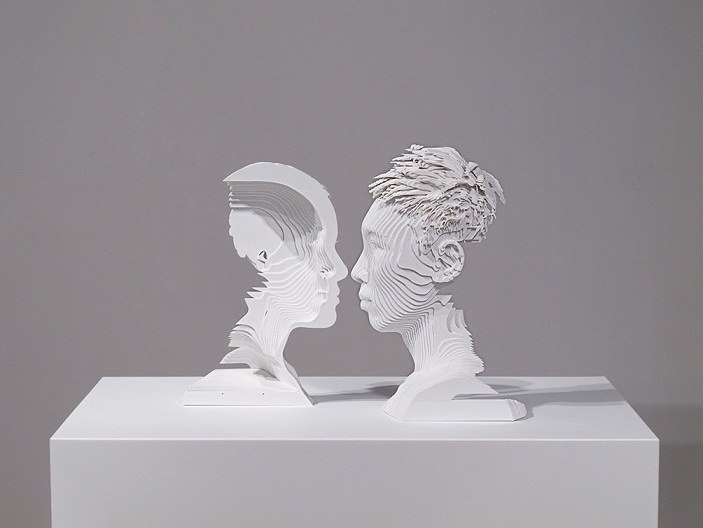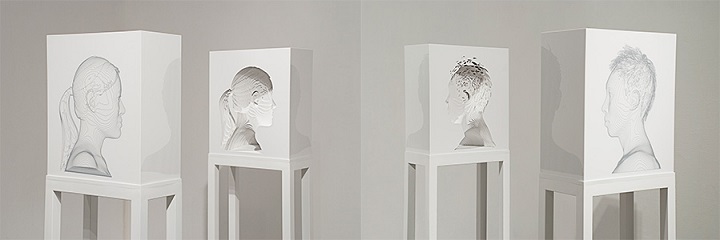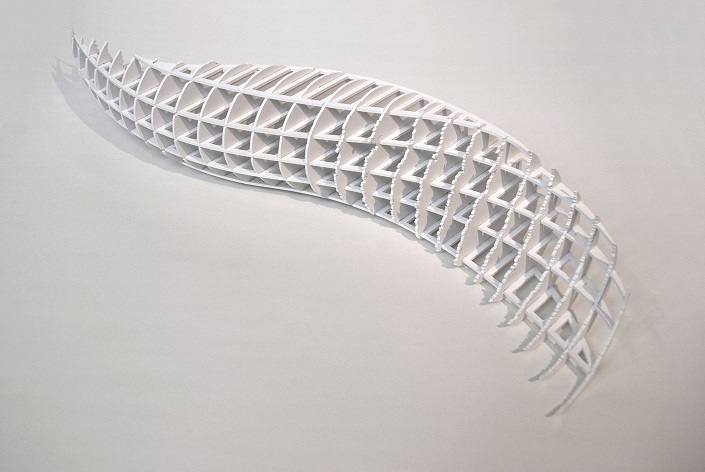藝評
Otto Li Tin Lun: Digital to Analogue via Pixels
約翰百德 (John BATTEN)
at 1:56pm on 14th June 2013





Captions:
1. Resolutions, 2012, size variable, resin & acrylic boards.
2. Relation in Time, 2012, 34 x 44 x 26 cm, acrylic boards.
3. Virtual Molding, 2012, 39 x 18 x 33 each, acrylic boards, silk screen printing.
4. Structure from the Moon Cycle, 2011, 12 x 67 x 18 cm, spray color on acrylic (Edition of 3+1).
5. A Halo of Counting Down, 2012, 30.7 x 33.5 x 33.5 cm, stainless steel (Edition of 10).
Photos courtesy of EC Gallery
(原文以英文發表,評論一分唯一 - 李天倫個展。)
Otto Li Tin Lun’s seven years as a digital animation designer immersed in a virtual world only increased his interest in its opposite: physical forms of representation. This was initially expressed in his attempts to specifically translate the basic blocks of digital imagery – pixilated cubes of colour seen in greatly enlarged digital photographs - into a sculptural form.
Since graduating in fine arts from The Chinese University of Hong Kong and later completing a Master’s of Fine Arts in 2012, these ‘pixel’ sculptures have become increasingly challenging and more complex. His earlier efforts, seen in such work as Daily Object No 2 (2006), used rectangular oblong lengths of different coloured wood, similar to children’s Cuisenaire rods. These ‘building blocks’ were arranged like a topographical model of peaks and valleys, giving an affected pixel-like image. Initially, these structures were simple, replicating a photograph or computer screenshot three-dimensionally or of easily recognised objects. Li had not quite broken free from a conventional form for this type of sculpture: the early pixel work could be hung on a wall, like any picture. He was, however, soon to expand his approach.
Fascinated by their form, Li has recently built sculptures that have become more intricate, often designed by computer modeling software and built using laser-cut plastics and careful assembly. The most complex example is Amitabha (2009) – a large pixel-like sculpture of The Buddha, appropriately installed in an exhibition about the Silk Road. Li has also experimented in using this building block form to represent sound. In his ten metre long Ludwig van Beethoven Symphony No 5 in C Minor, First Movement (2009), the first movement of Beethoven’s Fifth Symphony was built as a representation of the music and although the different pitch of the musical notes was only notionally represented, there was an uncanny physical resemblance with the music’s aural qualities.
Li’s most recent work experiments with positive and negative space using sculptural forms. Commissioned in early 2013 for Hong Kong ArtWalk, Parking 12 Contours is an ostensibly simple sculpture of a motorcycle, but executed as a complex abstract idea. Li’s unique rendition is achieved by strategically placing a series of clear perspex slices upright on a brightly lit light-box base. These slices are carefully shaped allowing the light to catch the outline of the motorbike’s detailing. Seen from a side (negative) view, only the perspex cross-sectioned slices are visible, seen from the (positive) full-front view the motorcycle becomes apparent.
This ‘cross-sectioned’ approach to sculpture has also been used to present head busts – notably of Li himself and his wife, see Relation in Time (2012). Executed in laser-cut sectioned plastic, these busts have a photogenic and uncomfortable cyber-accuracy. Helpfully, Li often shows his computer modeling designs for these busts: multi-angled line drawings or as a moving sequence shown on a computer monitor. This is a generous opportunity for viewers to glimpse the work behind a finished art piece.
Li’s approach to art is not solely serious. His love of football has produced a continuing series of artwork devoted to the game. His 3 Teams One Match (2008) is an absurdist goal-in-almost-three-corners soccer pitch originally installed at the decommissioned Victoria Prison in Central Hong Kong and then later enlarged as an interactive functional artwork placed inside a mall for shoppers to play on! His initial interest in bodily movement was also inspired by football and rendered in painted depictions of Italy shaped as a striker’s leg kicking a football in his Golden Right Leg (2003) series.
Offering a variety of work, this mini-retrospective of Otto Li’s ideas is an excellent opportunity to revisit his earlier and appreciate his current artwork, looking towards his future.
Exhibition:
Divided into One - Otto Li Solo Exhibition
This introductory essay was published in Otto Li Tin Lun's exhibition catalogue, Divided into One, for his exhibition at EC Gallery, Hong Kong, 6 to 26 June 2013.
